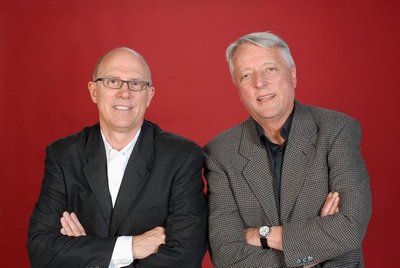June 3, 2010
Productive partnership: UW’s David Miller and business partner Robert Hull share honor from American Institute of Architects
When Dave Miller was a Peace Corps volunteer in Brazil during the late 1960s, he designed and helped build inexpensive but sturdy houses for the working poor. Made of earth blocks stabilized with cement, the houses weren’t fancy but as part of honoring context, they included porches important to Brazilian culture.
Miller also designed privies at a site for poor people who, because they embarrassed powerful Brazilians, had been removed from an area near a large airport.
These days, Miller is chairman of the UW Department of Architecture and a co-founder of the Miller│Hull Partnership in downtown Seattle. He’s worlds away from poverty in Brazil, but the experience with simple, efficient design and materials close at hand shaped both Miller and his business partner, Robert Hull, who had similar experiences as a Peace Corps volunteer in Afghanistan.
For their service to the architectural profession, the community and the arts, Miller and Hull have been named recipients of the 2010 American Institute of Architects Seattle Medal.
“Bob Hull and Dave Miller have built a singular practice, internationally recognized for its elegant reformulation of modern critical regionalism,” said Daniel Friedman, dean of the UW College of Built Environments.
The two men are leading practitioners of Northwest Regionalism, which focuses on the dramatic landscapes of the Pacific Northwest — the unique light, often affected by water and clouds, and a preference for natural materials, particularly wood. Sustainability is a key link between those concerns and is an ongoing concern at Miller│Hull. In his 2005 book, Toward a New Regionalism: Environmental Architecture in the Pacific Northwest, Miller laid out a key definition: “Architecture that heals the heart, our biological systems and the environment is sustainable.”
Northwest Regionalism fits the spare, use-only-what-you-need attitude Miller and Hull bring to their work: “We hate extravagance,” Miller said. “We like to do simple and efficient — direct and rational solutions that have integrity and simplicity.”
Miller │Hull projects include the Fisher Pavilion at Seattle Center, Bainbridge Island City Hall and the UW Conibear Shellhouse and Athletic Center — all with the same simplicity, efficiency and attention to context.
Miller, 65, and Hull, 64, have been friends since their days at Washington State University, which in 2007 awarded them its Regents’ Distinguished Alumnus Award. Miller│Hull designs have often been joint efforts, one partner creating the design, the other offering critiques as the work goes along.
Miller calls two projects his favorites.
One is a 450-square-foot house in eastern Washington for Ed Marquand, owner and creative director of Marquand Books, a Seattle firm which designs and produces art books and websites for artists, museums and collectors. An admirer of Tadeo Ando, the Japanese architect known for international modernism, Marquand asked for a home that would minimally impact its site yet be comfortable and aesthetically pleasing.
He and Miller eventually decided on an off-the-grid house built from block material common to industrial and agricultural buildings in the Yakima Valley. A tower stores water for the house, and light comes from candles, kerosene lanterns and occasional use of a generator.
Miller’s other favorite is the 1310 East Union Lofts on Capitol Hill in Seattle.
The 40-by-80-foot site is smaller than a typical residential lot in the city. It’s also wedged midblock, between other buildings. “We had to solve so many problems to get that project built,” Miller recalled.
Fire regulations, for example, require two exits. Miller│Hull created a set of stairs but also installed glass and aluminum-frame garage doors that roll up, converting living and dining spaces to exterior balconies — and means for fire rescue workers to remove residents if need be.
The building also uses a German system of stacking cars via lifts, meaning less space necessary for parking.
Miller spends about half his time at the firm’s offices, the rest at the University. Hull notices energy Miller brings to his work as the result of teaching and working with students. Miller, he said, has also brought the best students to the firm as either apprentices or employees. Asked what Miller finds hard, Hull said, “We don’t live for organizing; we live for design. I think Dave gets antsy when not working directly on projects.”
Musing on their partnership, Hull added, “I don’t think we’ve had a cross word in 34 years; we just don’t take confrontational approaches.”
But they do expect honest opinions based on shared beliefs about architecture.
“People say don’t go into business with your best friend, but for us,” Hull said, “friendship carries the day because there’s that underlying respect we have for each other.”


